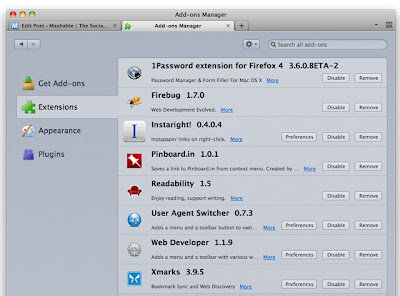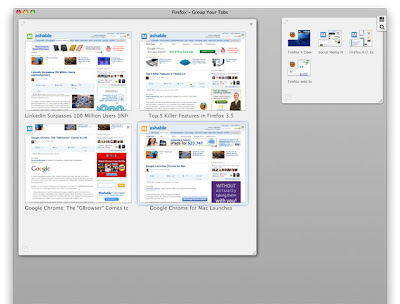


Over the last few years, early adopters — once the core evangelists for the browser — shifted away from it. Those add-ons started to bog the program down. Meanwhile, the new layout engine of choice for web developers isn’t Gecko (which powers Firefox), but WebKit (which powers Apple Safari, Google Chrome, and the browsers for BlackBerry and Android). Firefox 4 is an important release for Mozilla — perhaps the most important release since 1.0. The competition has never been so strong. We have been using the beta releases extensively and spent some time with the final release. So how does Firefox 4 stack up against the competition? Are the changes enough to keep current users from switching — and lure old users back?
________________________________________
Look and Feel
________________________________________
Mozilla first started talking about Firefox 4.0 in July 2009. The early screenshot previews — featuring tabs on top, a la Chrome — were a radical departure at the time. Although the comparisons to Chrome are unavoidable, I think that Firefox 4 improves upon Google’s minimalist design. Tabs are on top, but the browser window is still easily draggable. Users won’t make the mistake of dragging a tab rather than the full window. Moreover, cycling through tabs is more elegant and less cluttered than either Safari 5 or Chrome 10. By default, Mozilla has changed the location of the home button. It also added a new bookmark bar. Fortunately, these components can be customized and removed (simply right click on them and hit “customize”). Like Chrome, Firefox eschews the the status bar on the bottom of the screen, only using it as an overlay when needed. This adds a few more pixels of space to the viewing window. Firefox 4 includes an innovative new tab grouping feature known as Panorama. Panorama started life as Tab Candy, an experimental feature introduced by former Mozilla Creative Lead Aza Raskin. It creates different groups of tabs and lets you switch easily between them. Panorama is a great feature for power users, but anyone who don’t want to use a grouping system can ignore it and never know the difference.
________________________________________
Speed
________________________________________
Firefox used to be the fastest browser on the block. Over the years, the program has become bloated. Increasingly, the speed factor in web browsers is less about the rendering engine and more about the JavaScript engine. Firefox 4 claims to be up to six times faster than its predecessor. In our tests, load times did seem about that fast — though Google Chrome 10 still seems to bring up pages more quickly. The speed increases aren’t merely limited to page load times, however. Firefox 4 starts up significantly faster on my Mac (an iMac with a 2.8GHz i7 and 12GB of RAM running Mac OS X 10.6.7) than its predecessor. In fact, in a timed test, Firefox 4 launched from dock to default homepage at nearly the exact same speed as Google Chrome 10.
______________________________________
Performance, Memory Usage, Stability
______________________________________
As a full-time Mac user since 2007, I’ve long had a love/hate relationship with Firefox. Certain websites (particularly corporate backend systems) just work better in the browser than in Safari. But Firefox has never been particularly well tuned to Mac OS X machines. Firefox 3 was a significant improvement, but frankly, Firefox has remained a memory hog. The biggest problem with Firefox versions of the past — and this is true of both Mac OS X and Windows releases — is that the program has the tendency to leak memory. This problem only gets worse on systems with lots of add-ons installed and can be made worse still by plugins like Flash. Mozilla has said that Firefox 4 consumes less memory and is more stable. I wanted to see if this was true. Using the Activity Monitor in Mac OS X, I tracked the amount of real memory, CPU utilization and CPU threads in Firefox 4, Firefox 3.6.15, Safari 5.0.4 and Chrome 10.0.6.448.151 stable. I tried to install the same number of add-ons or extensions to each browser. The goal was to re-create the average browsing session. I then opened a number of memory-hogging tabs, including Farmville and Hulu with video playing. I tested the memory and CPU usage for each browser. Remember, your mileage may vary First, the good news — in my tests, Firefox 4 consumes less memory and CPU cycles than Firefox 3.6.15. When adding in Flash and other plugin usage to the total memory footprint, only Google Chrome 10 performs better. The bad news — and this is really for all four browser variants tested — is that the overall usage is still fairly high. The big culprit here is Adobe Flash. Improvements have been made on this front in Windows and with certain graphics chipsets on the Mac (my Radeon HD 4850 unfortunately, is not included), but Flash is the greatest cause of browser performance and memory usage issues. So if Firefox 3.6.x takes up a lot of memory on your system, the improvements in Firefox 4 might not be significantly better. What is new is that Firefox 4 now segregates its regular browsing processes from so-called plugin processes. Previously, Firefox was the sole item to appear in the Mac OS X Activity Monitor. With Firefox 4, a “Firefox Plugin Process” appears as well. So if Flash wasn’t running a game and playing back a video, that Plugin Process usage would be considerably less. Rather than relying on the browser to free up the memory (something Firefox is historically bad at doing), the plugin process can simply be freed up. Moreover, if a plugin crashes, the browser can recover without taking down the entire session. Apple is doing something similar in Safari 5.0.x, which shows Flash Player as its own process. If Flash crashes, the rest of the browser can stay intact. With Chrome, Google goes a step further and actually separates each tab into its own process. That makes it easy to shut down one tab and keep the rest of the session running. Chrome doesn’t separate Flash as its own entity; the browser uses its own sandboxed version of Flash Player. It’s great that Mozilla has decided to split up the way Firefox uses memory. Recovering from crashes is less time consuming, and regular system memory can be reclaimed more quickly. Since Firefox 4 Beta 8, I have found the browser to be very usable with few stability issues. The few issues that remained up until the final release — notably Netflix not wanting to work well on the Mac — have been resolved in Firefox 4. In the 24 hours I have been testing Firefox 4, I haven’t had the browser seize or crash. It’s rare that I don’t have to invoke “force quit” for Firefox 3.6.15, so this is a great sign.
________________________________________
Add-ons
________________________________________
Mozilla has restructured how its add-on system works. Add-on installation and browsing now takes place in a designated browser window, rather than a pop-up menu. This is much more easy on the eyes and makes finding and installing or removing add-ons and browser themes more fluid. Most major Firefox add-ons now work with Firefox 4. Users may run into situations where an add-on is incompatible. But most developers seem to have answered the call. If your favorite add-on isn’t updated in the next week or two, it might be time to look for a replacement; it probably indicates developer abandonment. Firefox is continuing to move towards lighter weight extensions like those for Google Chrome, Safari and Opera. These add-ons can be built using HTML, CSS and JavaScript and tend to use less memory and resources. They also tend to have less of an impact on overall browser performance and stability. Still, at this stage, most major Firefox add-ons still use the traditional add-on API and require a browser restart when updated, installed or uninstalled. I have long said that add-ons and extensions are Firefox’s greatest strength and its greatest weakness. The impact that the extensibility these add-ons added to the browser on overall user adoption cannot be understated. It’s equally true, however, that the performance impact some popular add-ons can have on the browser has hurt Firefox’s image as a whole. Even with Chrome, users have to battle how many extensions are installed versus the performance impact on the browser. It’s a tough line to straddle between utility and performance. But from what I understand about the Firefox add-on APIs and toolkits, it is an area Mozilla has spent a lot of time working to make better.
________________________________________
Overall
________________________________________
So is Firefox 4 good enough to lure back old users and to keep existing users satisfied? For me, the answer is yes. While I don’t anticipate using Firefox as my primary browser (I tend to use Safari), keeping Firefox running on my computer is no longer something I fear. The new user interface is fresh and inviting. Panorama is something I could see using on a regular basis, and the memory and performance improvements live up the expectations. Firefox fanatics are going to love it. Developers that test in multiple browsers are going to be very pleased. Still, I don’t know if being on par with the competition is enough to bring old users back. I’m going to continue to use Firefox 4 more over the next few weeks. For me, that’s an important development. Since Google Chrome officially came to the Mac in December of 2009, I have used Firefox primarily only to access certain websites behind a VPN. It’s great to actually enjoy using the old girl again. Let us know your thoughts about Firefox 4 in the comments.



